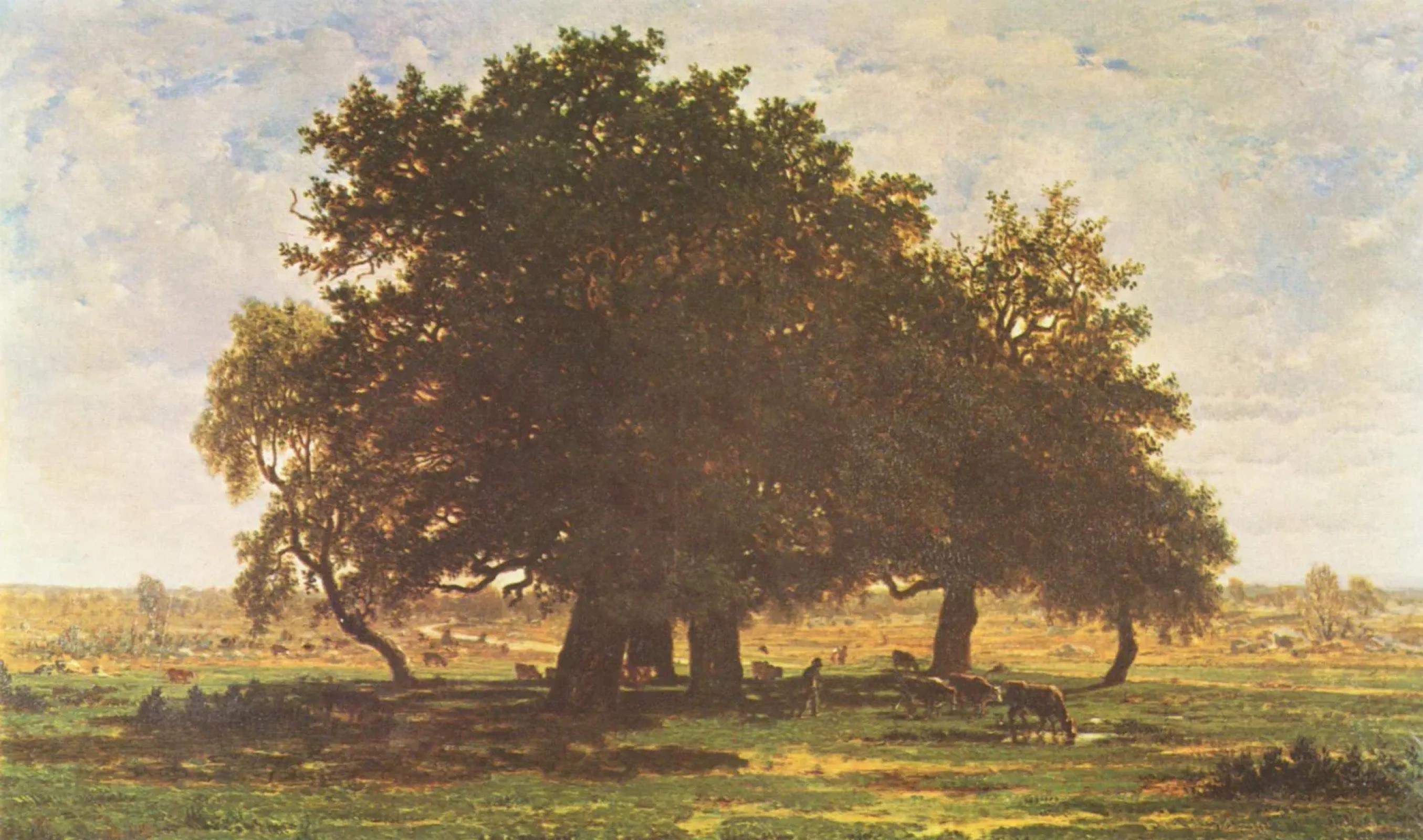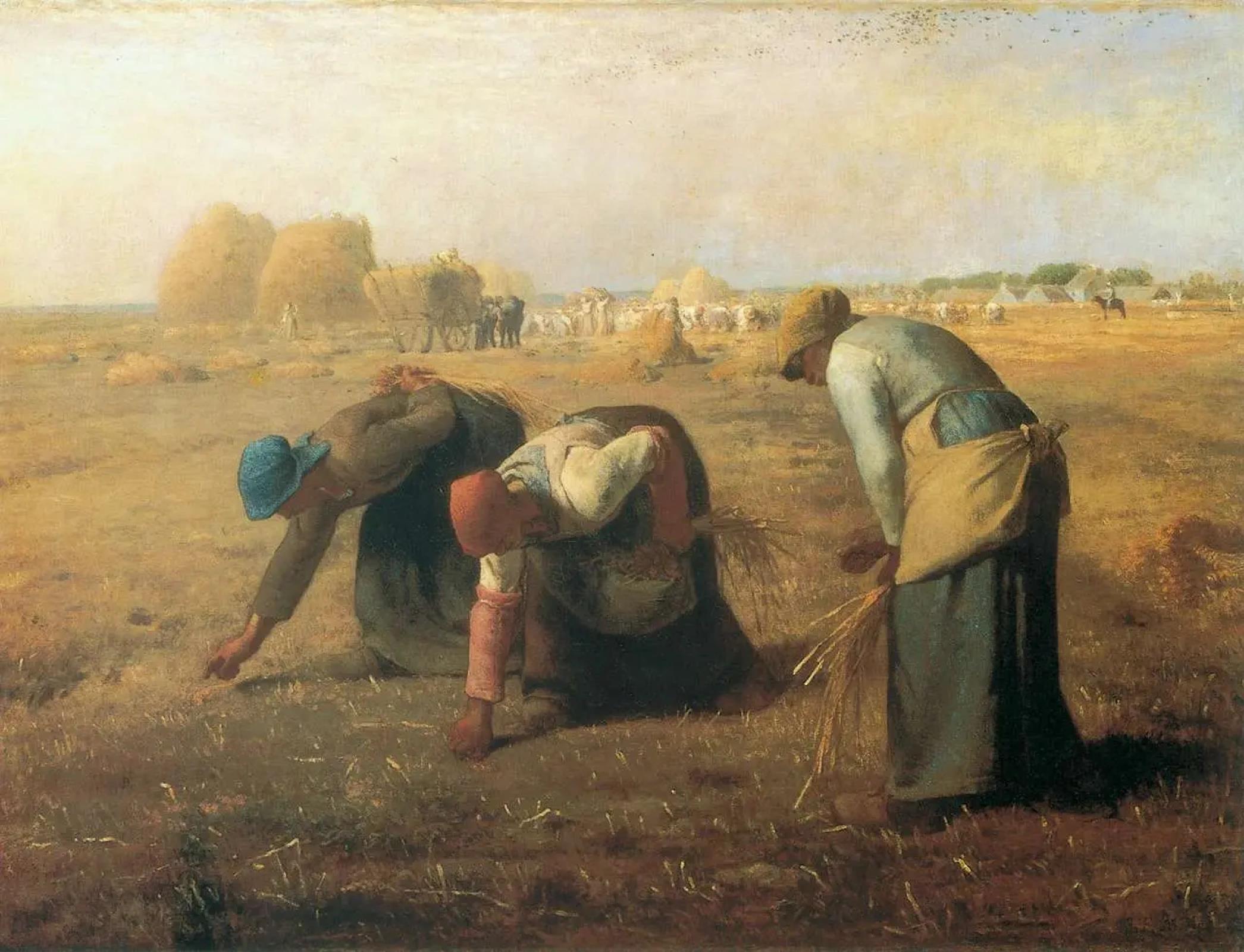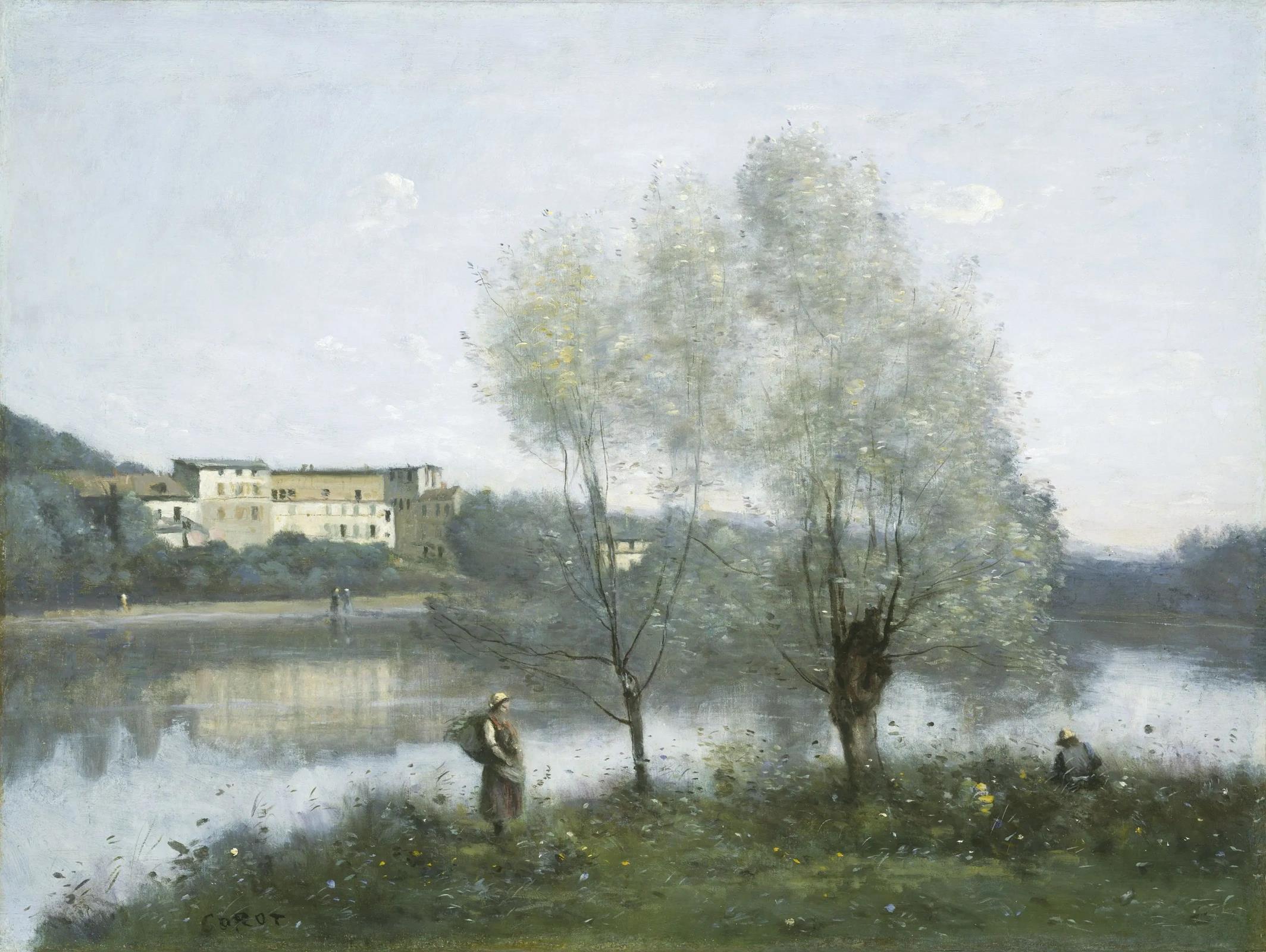| ALL |
|
Barbizon school (1830-1860)
| OVERVIEW / HISTORY / CHRONOLOGY / EXHIBITIONS / ARTISTS / GALLERY / BIBLIOGRAPHY / BOOKS / MORE |
| |
|
| OVERVIEW |
The Barbizon school (circa 1830–1870) is an art movement which occurred in France in the 19th century and was named after the village of Barbizon near the forest of Fontainebleau. The group of artists led by Théodore Rousseau rejected the traditional classical style of painting and aimed to convey nature in a more realistic manner. In 1824, the Salon de Paris exhibited works of John Constable, which influenced some younger artists with his rural scenes. The painters believed in inspiration that could be drawn directly from nature, and their main idea was to work in the open air. Trying to convey life as it is and represent its every aspect, from the awesome to the mundane and ordinary, they painted such subjects as the lives of farmers, gravediggers, woodsmen, poachers, and other workers. The leaders of the Barbizon school were Georges Michel, Théodore Rousseau, Jean-François Millet, and Camille Corot. Most of them were rejected by the Salon de Paris but nevertheless paved the way for such movements as Impressionism. |
|
|
| |
|
| |
|
| |
|
| |
|
| HISTORY |
When the future Impressionists were first learning their métier, landscape painting was still regarded as being less important than the representation of supposedly more noble and elevated themes. It is true that by 1817 an official award for landscape painting had already been established (by the same Valenciennes whose treatise Pissarro admired); but the very title of the award - 'for historical landscape' - hints at the barrier of prejudice which had to be surmounted before nature could be painted in its actual and haphazard state rather than in composed and imaginary forms. The traditionalists thought that nature in the raw lacked that sense of permanence and nobility which could only be imparted to it if its elements were rearranged to form an idealized whole. They also maintained that landscape should be embellished with human figures borrowed from the classical tradition. Those who held this belief controlled the Salon which, until Courbet and Manet opened private exhibitions of their own, remained the only place where a young painter could show his work. The Salon was the goal of the Barbizon painters, as it was of Corot and the early Courbet. At a later stage Manet still advised his friends, including the Impressionists, to show there, since it was the only place where they could find buyers other than the few friendly amateurs who already knew about their work. The jury of admissions and awards at the Salon was controlled by the Academy of Fine Arts, whose administrators also helped to decide which paintings should be purchased for museums as well as the award of commissions for mural decorations.
Once the Barbizon school, particularly Rousseau, Daubigny and Millet, had adopted open-air painting (and Rousseau began as early as 1827), anecdotalism declined and illusionism, together with the study of light, progressed rapidly. Rousseau called light 'the secret of Prometheus' and wrote: 'Without light there is no creation, everything is chaos, death or pedantry.' The Barbizon painters, when compared with the mature Impressionists, seem to aim at achieving an effect of permanence: their light is so much less free and changeable, so much more closely bound to the objects represented. Yet if we compare them with painting of an earlier period, their light is extremely variable, and Rousseau and Daubigny even painted what were virtually a series of the same subjects under different conditions of light and weather - thus anticipating Monet. Daubigny was often attacked for painting only 'an impression'. Gautier made this charge against him in 1861, and in the next sentence accused him in effect of being an Impressionist in the manner of Monet. 'Each object is distinguished by a real or apparent contour, but the landscapes of M. Daubigny offer little more than a juxtaposition of spots of colour.' Thus amongst the Barbizon painters the visual approach gradually ousted the structural. Eventually artists were to become more interested in the small dabs of paint than in what they represented. But Millet, Rousseau and Daubigny did not reach that point; they still had a more Romantic interest in nature. As Rousseau said: 'I understand by composition that which is in us entering as deeply as possible into the external reality of things.' There is no lack of evidence for the influence of the Barbizon painters on the Impressionists. The young Monet's letters to Boudin, written from Paris, are full of praise for them. Thus in 1859 he declared: 'The Troyons are superb and for me the Daubignys are really beautiful ... there's a clever fellow for you who knows what he's about and who understands nature.... The Corots are absolute wonders.' And a year later he saw an exhibition of the school of 1830 which proved 'that we are not so decadent now as people think'; after mentioning 'the splendid Delacroix', he cited Millet and Corot. As early as 1856, when he had very little money, Monet bought a Daubigny.
The Barbizon painters developed in a period when a whole literature of country life came into vogue. Since 1832 George Sand had been celebrating her native Berry, which her friends Rousseau and Dupré liked to paint. Then Pierre Dupont published a novel called Les Paysans and a collection of lyrics, Chants Rustiques; and Courbet's friend Max Buchon translated German rural poetry as well as collecting the songs of the French countryside. The Barbizon group benefited from the revolution of 1848. Louis Blanc and the Fourierists had been demanding an art of actuality, and after Charles Blanc was made director of fine arts, state commissions were awarded to Millet, Rousseau, Daubigny and Dupré. But the social basis of the conflict between academic art and realistic landscape painting was underlined by Count Nieuwerkerke who, as Superintendent of Fine Arts, directed official patronage under the Second Empire; he said of the Barbizon painters: 'This is the painting of democrats, of those who don't change their linen and who want to put themselves above men of the world. This art displeases and disquiets me.'
Another painter who would have disquieted Nieuwerkerke after 1848 was Gustave Courbet, whom the public associated with Barbizon and whose style does in fact owe something to Millet and to Rousseau's paintings of the Auvergne. Courbet was more important to the Impressionists as a noisy, liberating force, a man who taught them not to fear subjects which seemed unpromising and casual, than as the exponent of any new technique. None of the Impressionists could have ignored his vehement statement of realistic principles in the Courrier du Dimanche in 1861: 'I hold that painting is essentially a concrete art and does not consist of anything but the representation of real and concrete things.' |
|
|
| |
|
| |
|
| |
|
| |
|
| CHRONOLOGY |
1824
The Salon de Paris exhibits works of John Constable.
1829-1931
Jean-Baptiste-Camille Corot comes to Barbizon to paint in the Forest of Fontainebleau. While there he meets the members of the Barbizon school; Théodore Rousseau, Paul Huet, Constant Troyon, Jean-François Millet, and the young Charles-François Daubigny.
1948
During the Revolutions artists gather at Barbizon to follow Constable's ideas, making nature the subject of their paintings. The French landscape become a major theme of the Barbizon painters.
The leaders of the Barbizon school are Théodore Rousseau, Jean-François Millet, and Charles-François Daubigny; other members include Jules Dupré, Constant Troyon, Charles Jacque, Narcisse Virgilio D?az, Pierre Emmanuel Damoye, Charles Olivier de Penne, Henri Harpignies, Paul-Emmanuel Péraire, Gabriel-Hippolyte Lebas, Albert Charpin, Félix Ziem, François-Louis Français, 3ò4mile van Marcke, and Alexandre Defaux.
1857
Millet portrays The Gleaners.
late 1860s
The Barbizon painters attract the attention of a younger generation of French artists studying in Paris. Several of those artists visit Fontainebleau Forest to paint the landscape, including Claude Monet, Pierre-Auguste Renoir, Alfred Sisley and Frédéric Bazille.
1867
Théodore Rousseau dies at Barbizon.
1875
Jean-François Millet dies at Barbizon. |
|
|
| |
|
| |
|
| |
|
| |
|
| EXHIBITIONS |
|
|
|
| |
|
| |
|
| |
|
| |
|
| ARTISTS |
Corot, Jean-Baptiste Camille
Corot, the real forerunner of modern landscape painting, brought back from Rome, as did his two friends Edouard Bertin and Caruelle d'Aligny, a number of closely observed but somewhat austere studies of the Roman Campagna that showed a fresh vision and attitude to the classical landscape. These paintings are small in size, but are real masterpieces. However, the large compositions he painted for the Salon to please the Hanging Committee are definitely still in the neo-classical tradition, and lack his usual typical spontaneity and freshness. He also shows his originality as a painter, though indeed he sometimes reminds us of Manet. His Woman seated with her bare painted in 1835, Marietta (1848) and portrait of the Reverend Mother of the Annonciade Convent reveal a deep sense of hidden life as one finds in Vermeer, in spite of his apparently effortless simplicity. At the same time as he was working on series of Souvenirs of Mortefontaine and d'Avray, with peasant women carrying wood or mythological figures added just to please the authorities at the Academy, he also painted landscapes in various other parts of France: Chartres, Brittany, Douai or the Isère Valley. These landscapes are very moving in their simplicity, and have an extraordinarily fresh youthful appeal.
Millet, Jean François
Millet was the son of a peasant from Normandy and the eldest of eight children. He began drawing while still working on the farm. In 1883, he started lessons with the painter Dumoncel, also known as Mouchel, at his Cherbourg studio, and in 1885, he went to Langlois de Chevreville to study. He was awarded a scholarship by the municipality of Cherbourg, which enabled him to go to Paris. He settled there in 1837 and became a student in Paul Delaroche's studio, while also working at the Louvre and the Académie Suisse.
When he returned to Cherbourg, he painted portraits and shop signs and attempted some nudes. After his marriage, he moved to Barbizon, where he became known as one of the artists of the realist school, focusing mainly on simple workers and peasants. Critics were not favorable, labeling him "a painter of low life" and "revolutionary." However, his friends, including the painter Théodore Rousseau, supported him, and toward the end of his life, he finally gained fame.
Like Courbet and Rousseau, he can be considered to have anticipated Impressionism in some of his paintings, particularly in his love of nature and his sensitivity to light. This was especially evident in his final period when his color palette became lighter, and he made more use of bright reflections and highlights. At the same time, his opaque shadows were lightened through a "multiplicity of close, lively brushstrokes that made his surfaces shine and reflect the light."
Rousseau, Theodore
Troyon, Constant
His first job was as a painter at the Sèvres porcelain factory. Théophile Gautier was the first to recognize his distinctive style in "Tobias and the Angel," which was exhibited at the Salon in 1841. This was followed by landscapes such as "Vue prise aux Environs de Vannes" (1839) and "Vallée de Chevreuse" (1846). He became aware of his aptitude for animal painting after a visit to Holland in 1847. Works like "Bœufs rentrant au Labour" (1855, Louvre), "Retour à la Ferme" (1859, Louvre), "La Barrière," and "La Provende des Poules" (Louvre) are remarkable for their subtle light effects. Honfleur appealed to his romantic nature. Overworked, he enlisted the help of Boudin around 1861. Jongkind was greatly attracted to Troyon's work, and Troyon also provided advice to Monet. |
|
|
| |
|
| |
|
| |
|
| |
|
| GALLERY |
|
| |
 |
| |
Théodore Rousseau, Les chênes d'Apremont, 1852, Musée d'Orsay |
| |
|
| |
 |
| |
Jean-François Millet, The Gleaners, 1857, Musée d'Orsay |
| |
|
| |
 |
| |
Jean-Baptiste-Camille Corot,Ville d’Avray, c. 1867, National Gallery of Art |
|
|
| |
|
| |
|
| |
|
| |
|
| BIBLIOGRAPHY |
Barras Hill, Ian, Paintings of the Western World. Impressionism. Amsterdam, 1980
Eisenman F. Stephen, Nineteenth Century Art A Critical History. London, 1996
Pool, Phoebe, Impressionism. London, 1988
Serullaz, Maurice, Phaidon encyclopedia of Impressionism. New York, 1978
Wilson, Michael, The Impressionists. New York, 2002 |
|
|
| |
|
| |
|
| |
|
| |
|
| BOOKS |
|
|
|
| |
|
| |
|
| |
|
| |
|
| MORE |
|
| |
|
|